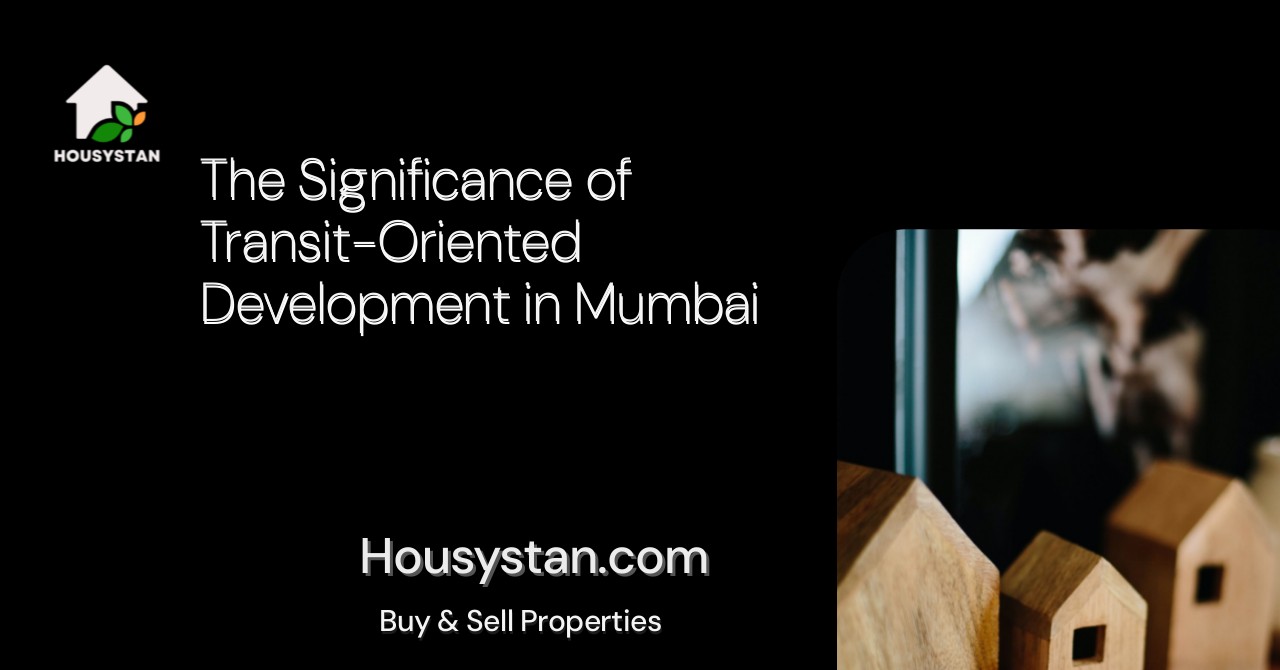The Significance of Transit-Oriented Development in Mumbai
Read latest blogs and articles from Housystan

The Information mentioned here was last updated on:
2/12/2025The Significance of Transit-Oriented Development in Mumbai
Mumbai, often referred to as the city that never sleeps, is a bustling hub of dreams, industries, and a labyrinth of roads and rails. Home to over 20 million people, it stands as one of the most populous cities globally. With such a dense population, urban planning is crucial to maintain a smooth flow of daily life. Enter Transit-Oriented Development (TOD), a transformative planning approach reshaping urban landscapes worldwide. In this article, we'll explore why TOD is becoming integral to Mumbai's metropolitan infrastructure.
What is Transit-Oriented Development?
- Verified Tenants/Buyers
- Unlimited Property Listing
- Zero subscription/charges fee
Transit-Oriented Development (TOD) refers to a mixed-use residential and commercial area designed to maximize access to public transportation. A TOD neighborhood typically features a central transit stop surrounded by a dense mix of amenities and housing options within walking distance.
- Mixed-use communities: Encourages a blend of residential, business, and leisure spaces.
- Pedestrian-friendly: Prioritizes walkable environments over automobiles.
- Proximity to transit: Built around efficient and accessible public transport options.
Why is TOD Important for Mumbai?
Mumbai's public transportation system is the city's lifeline. The city's trains, known colloquially as 'local trains,' cater to millions daily. However, the increasing population and vehicle numbers have strained the infrastructure, resulting in congestion and pollution. TOD offers sustainable solutions by enhancing urban mobility while reducing environmental impact.
- Alleviates traffic congestion: Encourages public transport over private cars, reducing traffic.
- Reduces pollution: Lower vehicle emissions contribute to cleaner air.
Key Components of Transit-Oriented Development
1. High-Density Development:
- Prioritizes high-rise residential and commercial buildings.
- Optimal land use allows more people to live and work near transit hubs.
2. Mixed-Use Spaces:
- Integrates retail, office, and residential spaces.
- Vibrant, self-contained communities that reduce the need for long commutes.
3. Accessible Public Transportation:
- Enhances connectivity through well-planned bus, metro, and train networks.
- Easy access reduces dependence on private vehicles.
4. Walkability:
- Safe sidewalks, pedestrian-safe crossings, street lighting.
- Green spaces, public squares promoting community interaction.
Current Transit-Oriented Development Projects in Mumbai
Mumbai is already embracing TOD with several projects underway, aiming to integrate its urban fabric with world-class transport facilities.
Mumbai Metro: An expanding metro network acts as a TOD catalyst. Strategic placement of metro stations supports dense residential and commercial development along its routes.
Suburban Rail Improvements: Modernization efforts are enhancing capacity and frequency of existing trains, supporting TOD by crowding out older, congested corridors.
Benefits of Transit-Oriented Development
Economic Growth:
- TOD areas attract businesses, spurring economic development.
- Higher footfall leads to increased retail and service revenues.
Improved Quality of Life:
- Better air quality and less noise due to decreased traffic.
- Enhanced public spaces improve community interactions.
Sustainability:
- Reduces urban sprawl by concentrating development within existing areas.
- Aids in conserving natural resources by minimizing ecological impact.
Challenges in Implementing TOD in Mumbai
Despite its benefits, implementing TOD in Mumbai comes with challenges.
- Land Scarcity: Mumbai's constrained geography complicates land acquisition for large-scale TOD projects.
- Funding and Investment: Significant capital investment is necessary, posing financial challenges.
- Coordination: Requires seamless coordination between government agencies and private developers.
Future Prospects of TOD in Mumbai
As Mumbai eyes a future of sustainable growth, TOD is expected to play a crucial role. The state has identified key areas for potential TOD projects, aligning with broader urban development goals.
Policy Support: The city government is increasingly supportive, creating policies favoring TOD initiatives and easing regulatory hurdles.
Public Awareness: Efforts to inform residents about the benefits of TOD can smooth transition by ensuring community buy-in and cooperation.
Internal Links for Further Information
- Mumbai Urban Transport Projects: Explore ongoing and upcoming transport infrastructure projects enhancing connectivity.
- Sustainable Development in Mumbai: Learn more about Mumbai's initiatives towards environmental sustainability.
Frequently Asked Questions about TOD
What makes TOD different from traditional urban development?
- TOD prioritizes public transit access and walkability, unlike traditional models that emphasize car use and suburban sprawl.
How does TOD help the environment?
- By reducing reliance on cars, TOD lowers greenhouse gas emissions and conserves energy.
Can TOD lead to gentrification?
- While TOD can increase property values, leading to gentrification concerns, careful planning can mitigate negative impacts.
Overall, Transit-Oriented Development holds immense potential for transforming Mumbai into a more efficient, sustainable, and livable city. By placing public transit at the heart of urban planning, Mumbai can address its current infrastructure challenges while paving the way for a brighter future.